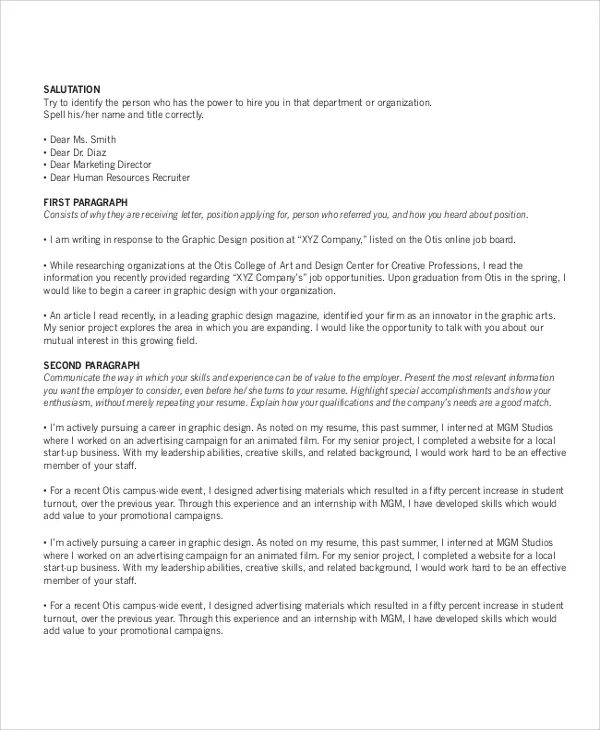Landing your dream job as an Art Director requires more than just a stellar portfolio. A well-crafted cover letter is your first opportunity to make a strong impression, demonstrating your skills, experience, and passion for the role. This guide will walk you through the essential elements of an effective cover letter, ensuring you stand out from the competition and increase your chances of getting hired. We’ll cover everything from understanding the role and its responsibilities to highlighting your achievements and tailoring your letter to specific job requirements. Let’s dive in and learn how to make your cover letter work for you. Crafting a compelling cover letter is a strategic art, one that can significantly increase your chances of securing an interview and ultimately, the job offer.
Crafting Your Art Director Cover Letter
Creating a standout cover letter for an Art Director position is a crucial step in showcasing your qualifications. It’s your chance to go beyond your resume and demonstrate your unique perspective and how you can contribute to a company’s visual communication strategies. A well-written cover letter not only highlights your skills and experience but also demonstrates your passion for design and your understanding of the specific requirements of the role you are applying for. This section will provide you with the key strategies to write a cover letter that grabs the attention of hiring managers, setting you apart from other applicants.
Understanding the Role of an Art Director
Before you start writing your cover letter, it’s essential to understand the core responsibilities of an Art Director. Knowing what the role entails will help you tailor your letter to highlight the most relevant skills and experiences. The Art Director is the visual leader of a project, responsible for developing the overall look and feel of a project. This encompasses everything from branding and advertising campaigns to website design and editorial layouts. Understanding the scope of this position ensures you can articulate how you can meet those demands effectively and efficiently. They oversee the creative process, ensuring the final product aligns with the client’s goals and brand identity.
Key Responsibilities of an Art Director
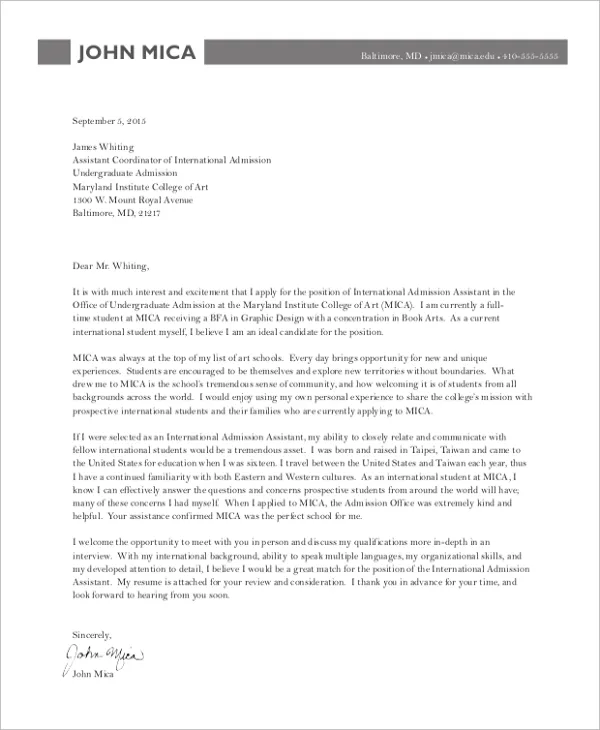
Art Directors wear many hats. Their responsibilities include conceptualizing and developing creative concepts, managing design teams, overseeing the production of visual elements, and ensuring projects are completed on time and within budget. Strong communication skills are vital, as Art Directors collaborate with clients, designers, photographers, and other stakeholders. A deep understanding of design principles, industry trends, and software tools is also crucial. Your cover letter should emphasize the skills and experiences that align with these critical responsibilities to make your application stand out. Successfully navigating these responsibilities requires a combination of creativity, leadership, and technical proficiency, all of which should be highlighted in your cover letter.
Essential Components of an Art Director Cover Letter
A well-structured cover letter is as important as your portfolio. It should be clear, concise, and professional, grabbing the reader’s attention from the start. A cover letter allows you to explain your interest in the company, showcase relevant skills, and emphasize your experience while demonstrating your understanding of the role and the company’s needs. Here’s a breakdown of the essential components that you should include. Remember to use a professional tone and proofread everything carefully before submitting it. Your goal is to make a strong first impression, and these components are key to achieving that.
Your Contact Information and Date
Start your cover letter with your contact information, including your name, address, phone number, and email address. Place this at the top left corner of your letter. Immediately following your contact information, include the date. This provides easy access for the hiring manager to contact you and adds a professional touch. This simple step helps make you more accessible and demonstrates attention to detail, both of which are vital for an Art Director. Ensuring your contact details are readily available prevents any potential issues in the hiring process and confirms your attentiveness to simple yet important steps.
The Recipient’s Information
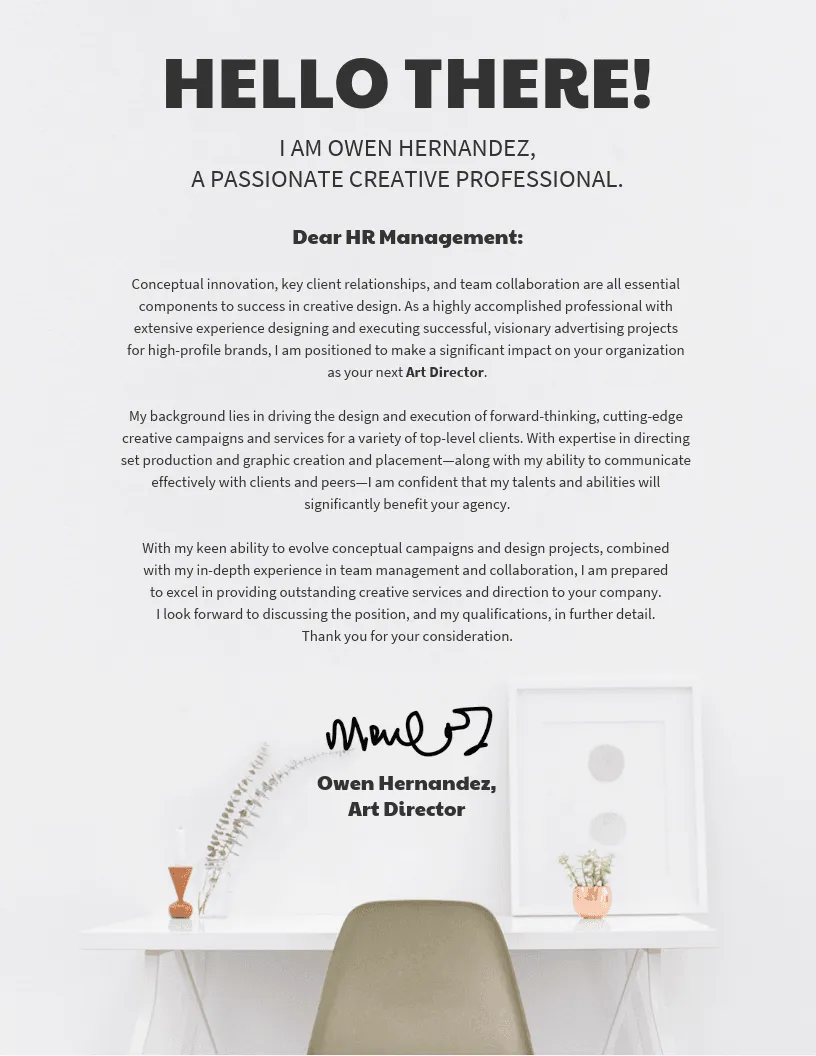
Next, include the recipient’s information. If possible, address your letter to the hiring manager by name; this shows you’ve taken the time to research the company. Include their title, company name, and address. Addressing the letter to a specific person makes it more personal, indicating that you value the opportunity and have a real interest in the position and the company. If you are unable to find the hiring manager’s name, use a professional greeting such as ‘Dear Hiring Manager’ or ‘Dear [Department Name] Team’. This personalization goes a long way in setting your letter apart from generic applications.
A Compelling Salutation
Start with a strong opening. Instead of generic greetings, craft a salutation that shows your genuine interest. For example, you might mention something specific about the company that caught your attention. This demonstrates you’ve done your homework and understand their brand and values. A compelling salutation instantly captures the hiring manager’s attention and motivates them to keep reading. Starting with a personalized salutation increases the likelihood of your letter being read thoroughly, giving you the chance to showcase your qualifications. Make sure your opening is both professional and engaging, setting the tone for the rest of your letter.
Highlighting Your Skills and Experience
The body of your cover letter is where you sell yourself. Highlight your relevant skills and experience, making sure to align them with the job description. Use specific examples to demonstrate your capabilities and quantify your achievements whenever possible. Focus on what you can offer the company and how you can contribute to its success. This section is the most important part of the cover letter, as it allows you to convince the hiring manager that you are a good fit for the role. Your goal is to present yourself as the solution to the company’s needs, so show how your skills and experience can benefit them.
Showcasing Relevant Projects
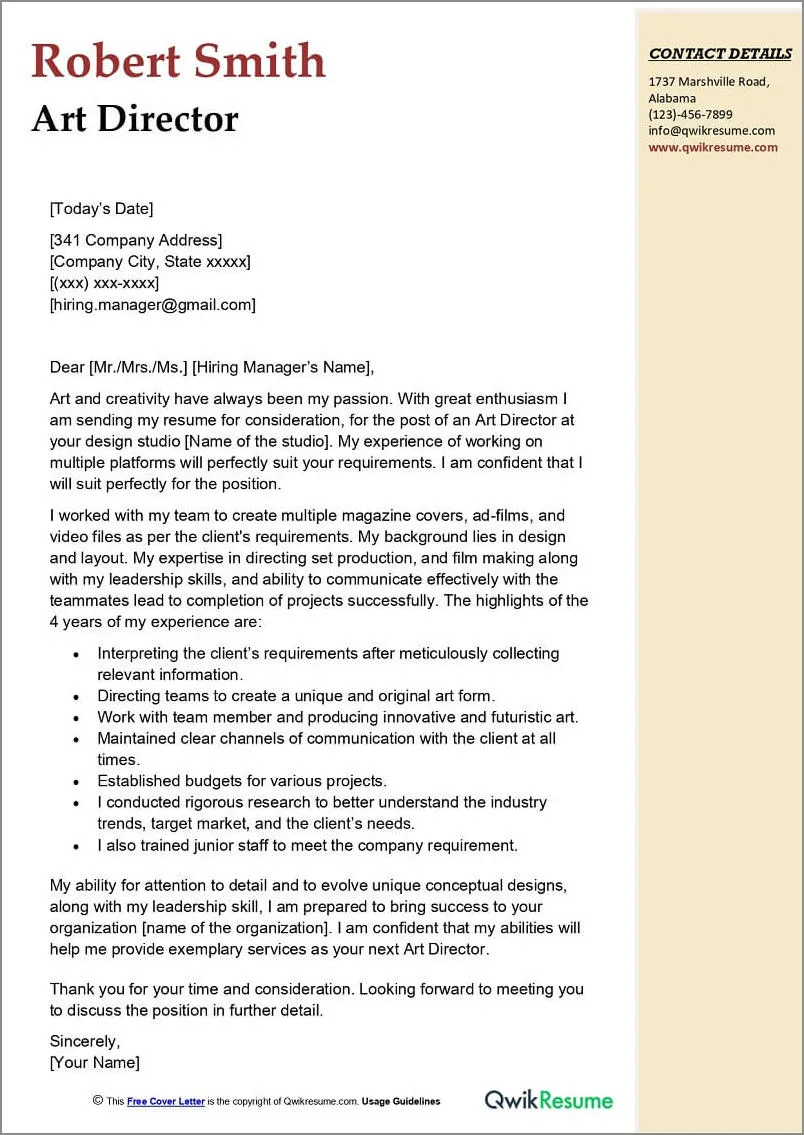
Include a brief description of a few relevant projects from your portfolio or past experience. Explain your role, the project’s goals, and the results you achieved. Be specific, mentioning any challenges you overcame and the design solutions you implemented. These examples should reflect your creative skills and ability to solve problems. Selecting the right projects will give the hiring manager a clearer picture of your abilities and your approach to design, making it easier for them to envision you in the role. Make sure the projects you showcase are closely aligned with the job requirements to prove your suitability.
Quantifying Your Achievements
Whenever possible, quantify your achievements. Instead of saying you increased sales, state by how much. Using numbers demonstrates your impact and makes your accomplishments more tangible. For example, you could say ‘Increased website conversion rates by 20%’ or ‘Managed a team that delivered a project ahead of schedule and under budget.’ These metrics show you understand the business implications of your work and your ability to deliver results. Quantifiable results show a clear and concise story of your accomplishments, making your case much stronger. It shows you don’t just create designs but also drive positive outcomes.
Demonstrating Your Design Philosophy
Use your cover letter to articulate your design philosophy. What are your core design principles? How do you approach creative challenges? Show how your values align with the company’s values and the requirements of the role. Sharing your design philosophy helps the hiring manager understand your creative process and what you bring to the table. This shows you are not just looking for a job but are passionate about design. Sharing this information will also reveal your vision of design, helping them understand how well your approach aligns with their company’s requirements. This adds personality to your application and helps the hiring manager connect with you.
Expressing Your Enthusiasm and Fit
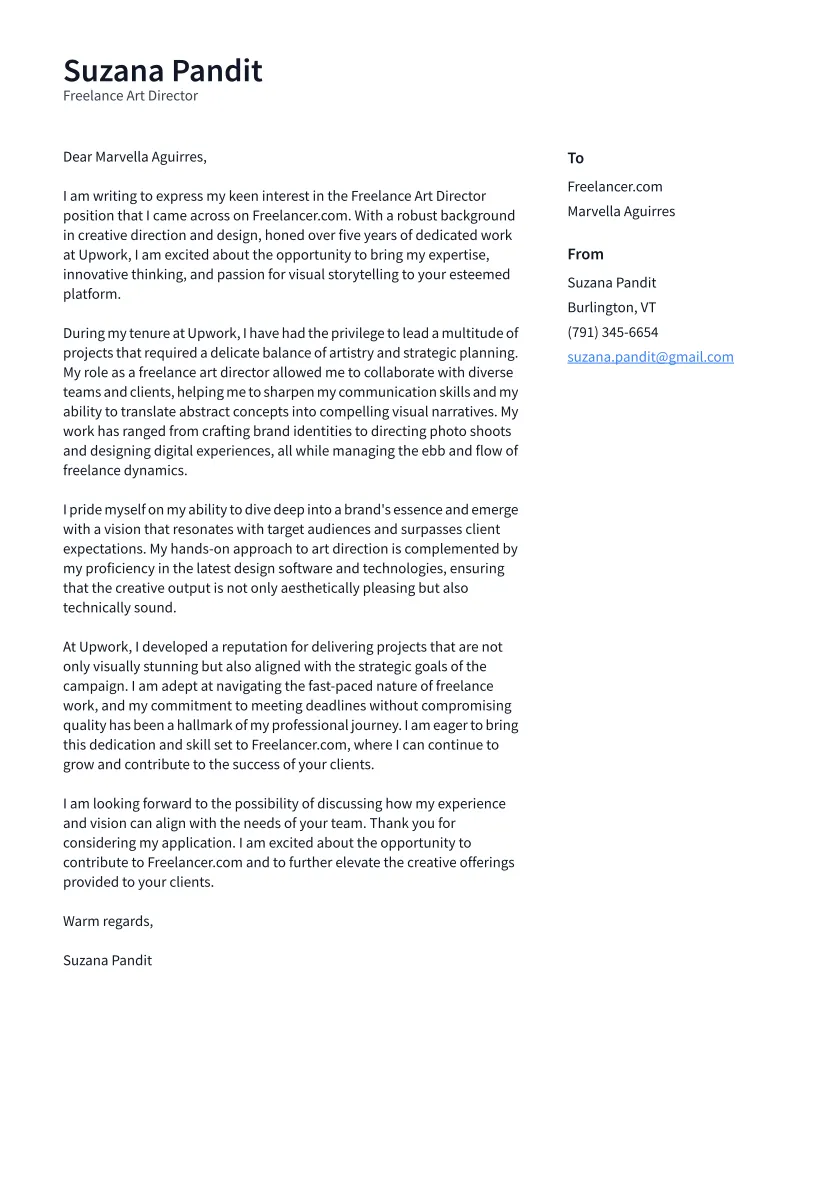
Beyond showcasing skills and experience, your cover letter should convey your enthusiasm for the opportunity and demonstrate how well you fit the company culture. Show your genuine interest and make it clear why you are interested in this specific role and company. Researching the company and tailoring your letter accordingly are essential to show that you’re genuinely interested and not just sending out generic applications. A cover letter that highlights your genuine enthusiasm and a good fit will help you stand out to the hiring manager. This will signal your readiness to contribute positively to the company.
Researching the Company Culture
Before you write your cover letter, research the company’s culture, values, and recent projects. This helps you tailor your letter to demonstrate how well you align with the company. Visit the company website, browse their social media, and read any recent press releases. Understanding the company’s voice and style will allow you to reflect that in your writing, showing you understand and appreciate their brand. Expressing this understanding indicates your willingness to be part of the team and contribute to the company’s success. This research can also help you identify specific areas where your skills and experience can make an impact.
Tailoring Your Letter to the Job
Don’t send a generic cover letter. Customize each one to match the specific requirements of the job and the company. Review the job description carefully and highlight the skills and experiences that are most relevant to the role. Tailor your language and tone to match the company’s brand voice. The goal is to show that you understand the job and are the right person to fill the position. Showing you have taken the time to customize your letter signals a higher level of interest and professionalism, enhancing your chances of getting noticed. This personalization proves that you are seriously interested in the specific role and have thought about how your skills can be applied.
Ending with a Strong Call to Action

Close your cover letter with a clear call to action. Express your enthusiasm for an interview and state how you can be contacted. This signals your interest in moving forward and makes it easier for the hiring manager to take the next step. Provide your contact information, including your phone number and email address, again. A strong call to action keeps the process moving forward, ensuring the hiring manager knows your next step. A call to action also emphasizes your keenness for the position and clarifies the next steps, which can expedite the hiring process.
Proofreading and Formatting
Your cover letter should be free of errors and professionally formatted. Poor grammar, spelling mistakes, and a messy layout can create a negative impression. Proofreading and proper formatting show attention to detail. Always proofread your cover letter thoroughly and have someone else review it. A well-formatted letter shows you take pride in your work. A polished cover letter is a reflection of your professionalism and attention to detail, and these are essential for an Art Director. This also assures that the hiring manager does not see any errors that could affect their first impression of you.
Ensuring Clarity and Conciseness
Keep your cover letter clear and concise. Use short paragraphs and straightforward language. Avoid jargon and overly complex sentences. The goal is to convey your message effectively and efficiently. Clarity ensures that the hiring manager understands your qualifications quickly and easily. The ability to communicate clearly is an essential skill for an Art Director, and your cover letter should demonstrate this. Be direct and to the point, highlighting your most relevant skills and experiences. Conciseness helps keep the hiring manager engaged.
Avoiding Common Mistakes
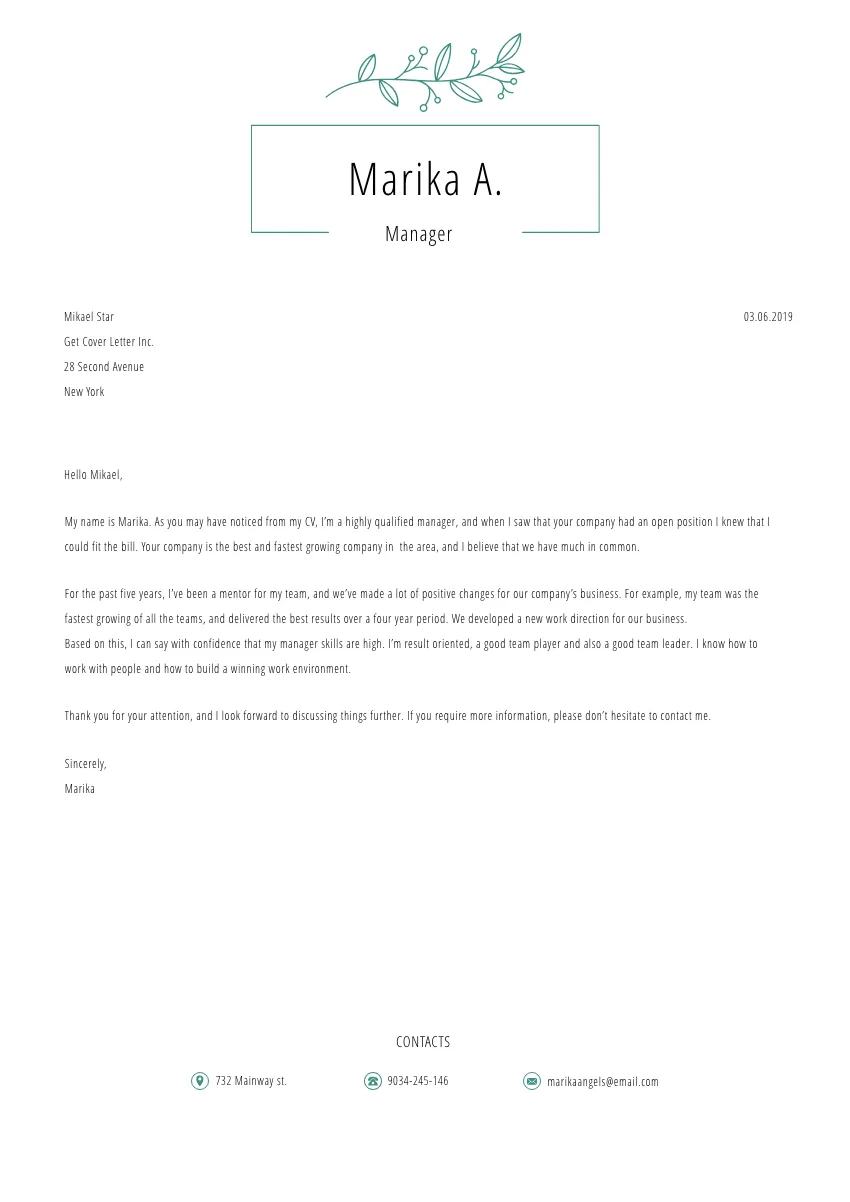
Avoid common mistakes such as typos, generic greetings, and long paragraphs. Do not simply restate your resume; use the cover letter to add context and explain why you are the best candidate. Do not include negative information about previous employers or jobs. Always tailor your letter to the specific job and company. A polished letter is a reflection of your professionalism and attention to detail. Avoid mistakes that could undermine your application. By steering clear of these common pitfalls, you ensure your letter conveys your capabilities in the best possible light.
In conclusion, creating a compelling cover letter is a crucial part of the job application process for an Art Director. By understanding the role, showcasing relevant skills, and tailoring your letter to each specific opportunity, you can significantly increase your chances of getting hired. Remember to always proofread your letter and present yourself in a professional and enthusiastic manner. Good luck with your job search.
